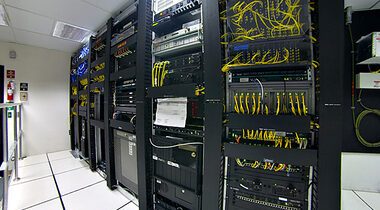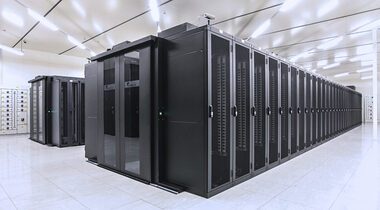ADAMANT Data Center
-
- Modular data processing centers (DPC) of the company's Data Center are located on its own territory and equipped with fault-tolerant infrastructure.
- Each Data Center has three levels of vandal-resistant protection and biometric access control system (ACS). Data of ACS is stored for more than 90 days.
- Access to the installed equipment is strictly regulated and carried out exclusively by the company's technical staff and clients.
- Data Center clients are given physical access to the installed servers in 24/7 mode.
- Entrance to the Data Center territory is possible only for authorized vehicles and is controlled by physical security.
-
- Data Center's two-level security system is ensured by the Center's own 24/7 guards and contractual relationship with the Security Police.
- Video monitoring of the adjoining territory, courtyard and Data Center premises is carried out with the help of 20 video surveillance cameras.
- The territory is fenced with vandal-proof fence.
- Access to the area is by prior arrangement and under the control of a representative of the Data Center duty service.
-
- Guaranteed power supply is provided by two independent inputs from the grid and an independent input from a diesel generator, which corresponds to the 1st category of power supply reliability.
- Each data center has 2 inputs of guaranteed power supply with load up to 120 kW.
- Ability to connect to uninterruptible power supply from 2 different inputs with an allocated capacity of up to 6 kW per cabinet.
- Control of more than 250 power supply parameters is carried out by the network analyzers installed on each data center input.
-
- The data center modules are equipped with an automatic gas fire extinguishing system filled with inert gas safe for the equipment.
- The operability of the firefighting system is monitored by the company's round-the-clock security guards, as well as by the city's subdivision of the State Emergency Service.
- The subdivision of the State Emergency Service of the city is located at a distance of about 1500 m from the location of the Data Center, a five-minute drive away.
-
- It is carried out according to the N+1 circuit.
- Modules provide 21°C ± 3°C with relative humidity up to 55%.
- 24-hour online monitoring of temperature and humidity.
-
- Connection of IP-KVM according to the client's request.
- Visual control (photo and video fixation), primary diagnostics and equipment rebooting (on request) by the system administrator on duty.
-
- Organization of access at the speed of 100/10000/10000 Mb/s from the company's equipment.
- Capacity of communication channels is 160 Gb/s.
- Optical inputs to the territory of the company are organized from two opposite sides, which provides fault-tolerance of access services.
- Equipment is connected to the points of traffic exchange UA-IX, DTEL-IX, Giganet IX by two alternative channels, there are own parity channels with the services of Google and Facebook platforms and other telecom operators.
- Third-party telecom operators are present on the premises of the data center.
-
- Providing space on NAS for data backup.
- Administration, reconfiguration and installation of OS on the server.
- Monitoring with notification via email or phone:
- server for Linux;
- equipment on the protocol snmp;
- The availability of the site (by http, https);
- check the validity period of the ssl certificate of the site.
- Installation of a web-camera and a door opening sensor in the rented enclosure.
- Performing crossover inside the rented cabinet by the company's personnel.
Data centre reliability levels
The main indicator of any data centre’s performance is its resilience.
One of the most common benchmarks for reliability assurance for most data centres has been the Telecommunications Industry Association (TIA) ANSI/TIA-942-A. American Telecommunications Infrastructure Standard. It specifies four levels of data centre reliability: basic, partially redundant, continuous service and fault-tolerant.
-
Tier I — at this level, the engineering infrastructure is not redundant and any failure of system components, as well as subsequent repair or replacement of equipment, leads to a shutdown of the entire data centre. The reliability of the infrastructure does not exceed 99.671%.
-
Tier ІІ — corresponds to an incomplete redundancy level of engineering infrastructure, repair and/or replacement of the main system components and equipment lead to a shutdown of the data centre. Infrastructure reliability does not exceed 99.749%.
-
Tier ІІІ — provides the possibility of redundancy and repair work to replace the main components of the system and / or equipment without stopping the data centre. The redundant components are in an inactive state. The reliability of the infrastructure is 99.982%.
-
Tier IV — any maintenance can be done without stopping the data centre operation thanks to the redundancy of the main systems. Key engineering systems are doubly redundant (redundant) on the scheme 2 (N +1). The reliability of the infrastructure is 99.995%.






